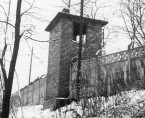- Museum
-
History
- Home Page - History
- Before the extermination
- Auschwitz I
- Auschwitz II-Birkenau
- Auschwitz III-Monowitz
-
Auschwitz sub-camps
- Altdorf
- Althammer
- Babitz
- Birkenau
- Bismarckhütte
- Blechhammer
- Bobrek
- Brünn
- Budy
- Charlottegrube
- Chelmek
- Eintrachthütte
- Freudenthal
- Fürstengrube
- Gleiwitz I
- Gleiwitz II
- Gleiwitz III
- Gleiwitz IV
- Golleschau
- Günthergrube
- Harmense
- Hindenburg
- Hubertshütte
- Janinagrube
- Jawischowitz
- Kobier
- Lagischa
- Laurahütte
- Lichtewerden
- Mesersitz
- Monowitz
- Neu-Dachs
- Neustadt
- Plawy
- Radostowitz
- Raisko
- Sonderkommando Kattowitz
- Sosnowitz (I)
- Sosnowitz (II)
- Sośnica
- SS Bauzug
- SS Hütte Porombka
- Trzebinia
- Tschechowitz (I)
- Tschechowitz (II)
- Auschwitz and Shoah
- Categories of prisoners
- Prisoner classification
- Fate of children
- Life in the camp
- Punishments and executions
- Camp hospitals
- Medical experiments
- Resistance
- Informing the world
- Evacuation
- Liberation
- The number of victims
- The SS garrison
- Holocaust denial
- Auschwitz Calendar
- Photo gallery
- Visiting
-
Education
- Home Page - Education
- Study visits
- Educational projects
- Conferences
- Thematic sessions
- Studies
-
Exhibitions
- Auschwitz, Memory, World
- Forbidden Art
- German Plans for Auschwitz Redevelopment
- June 14, 1940
- Leben? Oder Theatre? Charlotte Salomon 1917-1943
- Nazi German Death Camp Konzentrationslager Auschwitz
- People of Good Will
- Residents of Insurrectionary Warsaw
- So I am here kneeling down upon this Golgotha of modern times...
- The Liberation of KL Auschwitz
- The Memory of Auschwitz
- Traces of them remain
- Women at KL Auschwitz
- Visiting the Memorial
- E-learning
- Library - Online Catalogue
- Volunteer Bureau
- Resources for teachers
- ICEAH – General Information
- “Light of Remembrance”
- Contact
Gleiwitz III
A sub-camp located at an inactive mill belonging to Vereinigte Oberschlesische Hüttenwerke AG, part of which had been leased to the formerly Polish firm Zieleniewski Maschinen und Waggonbau GmbH, now under German trusteeship and evacuated from Cracow. The first transport of prisoners was sent there at the end of July 1944 and quartered in a masonry factory building. Initially they worked at putting the grounds in order, erecting a barbed-wire fence, and unloading machinery and installing it in the factory halls. Production started up late in the year, with the prisoners employed making train-car wheels, chassis for flak cannons, components for naval mines, and artillery shells. The director of the sub-camp was SS-Hauptscharführer Karl Spiker, who had a garrison of several score SS men at his disposal.
In October, the population of the sub-camp was about 600. They were evacuated on foot in January 1945, but they were soon turned back to the vacant Blechhammer sub-camp. From there, some of them joined prisoners from other sub-camps on a march to Gross-Rosen. Others managed to hide or escape. Those who could not do so were shot by the SS shortly before liberation.
